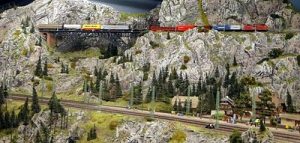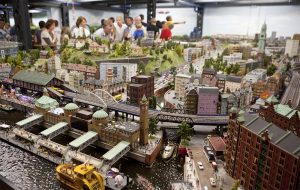
Miniatur Wunderland is the largest model train attraction in the world, ranging 16,038 sq ft with 50,525 ft of track in H0 scale, a way of representing distance in model train sets. The model railway is located in Hamburg, Germany and was created by twin brothers Frederik and Gerrit Braun. Though they each had successful careers in business and software engineering, they decided to idealize the one dream they both shared: building the largest model railroad in the world.

Though the project doesn’t address a specific problem besides the fact that the biggest model was not big enough, it is an important one in that it enforces creativity among children. Heavily designed for children, the artistic nature as well as interactive set up allow children to gain an appreciation for the physical nature of computing, such as the turning of play trains into things that move and produce light and make sounds.
The model is divided into nine sections: Harz, the fictitious city of Knuffingen, the Alps and Austria, Hamburg, America, Scandinavia, Switzerland, a replica of the Hamburg Airport and Italy. The insight that brought this project to life was a trip that Frederik Braun had taken to the alpine city of Zurich in July of 2000. Strolling through the alleys of Zurich, he came across a railway model shop, which evoked his wildest childish dreams. Upon discussing with his brother about the technological and economical advantages and disadvantages of the project of building the largest one in the world, they decided it was challenging and too exciting to turn down. To this day the project is still in construction, building and expanding across sections of Europe, and has been wildly successful and works with numerous moving parts.
This project relates to the themes of our class in numerous ways. The exhibit includes 1,300 moving trains (and over 10,000 carriages) navigating through cities, mountain ranges, villages and hillsides. When it’s dark, lights automatically turn on in the trains and throughout the cities and towns (which include a theme park and rides), sounds from the city can be heard, planes and cars move with respect to one another, and rivers and oceans with real water allow boats to float and move from place to place (without crashing). There are over 200 push buttons where people may make things happen throughout the set. The entire attraction is also monitored by a control panel, making the set essentially interactive to anybody. For the human world, it only really may be used as a spectated event, but it opens up possibilities for children anywhere to dream of building their own train sets and learn some history of Europe through the lens of trains. The set takes in information about its surrounding as well as users, uses it as input, combines it with information that it already has about location of the thousands of objects it has to keep track of, then produces outputs for lights, movement, sounds (such as during an “emergency”) and other imaginable outputs. The Braun brothers truly idealize the goals of our class: using imagination to create something spectacular with the simple tools we have. The solution to gain from this project is to be passionate about your project because having a personal goal will lead you a long way in making something great.

Sources:
http://www.miniatur-wunderland.com/exhibit/wunderland/wunderland-story/wunderland-story/
https://en.wikipedia.org/wiki/Miniatur_Wunderland#History
http://www.miniatur-wunderland.com/exhibit/wunderland/management/gerrit-braun/
Leave a Reply
You must be logged in to post a comment.